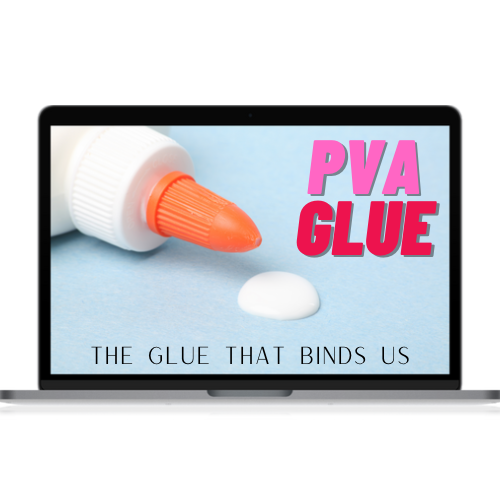What Common Glue Do We Use As Crafters?
Glue is not created equal, yes it’s very true, however which glues are we talking about? The most well known glue used for crafting, paper crafts and card making is probably Aleen’s Tacky Glue, or even more so, Elmers Glue, or Elmers School Glue, we used it in school, we used it as a stick glue or a paste and even clear(Not PVA). However Elmers school glue is not quite the same as Elmers Glue. Elmers School Glue is thinner, wetter, takes longer to dry and is washable with water after it dries. Elmers Glue is thicker, dries faster, washes off less easily and is pliable when dry. Most glues we use in our craft rooms are PVA, in fact branded PVA glues and if we are truly honest, we are probably paying way to much for all of them and could really just buy good old Elmer’s Glue and use it with just as much success.
About PVA Glue
Paper & Crafting Glues are typically PVA type glues PVA stands for polyvinyl acetate, and this is a specific type of aliphatic resin.
Polyvinyl Acetate is a water based resin and is used as the active ingredient in wood and paper glues. It is non-toxic, so it is useable in so many everyday items, from paper products, timber products, sealing wood and cardboard and more. PVA glue comes in 2 Main types White and Yellow. The yellow is much more expensive and more suitable to sealing items exposed to moisture or the elements. White PVA glue is more suitable to indoor use and can deteriorate over time especially if exposed to moisture or outside elements.
3 PVA Glues Types
Normal PVA Glue
Is mostly used for paper sealing, and often found in wallpaper paste, school glues, Craft glues etc… It is the easiest to find and the cheapest to purchase.
Polyvinyl Acetate Wood Glue
As the name suggest it is typically used for woodworking projects, due to it absorbing into the wood very well helping to create a solid bond. It is also used on other materials including foam, MDF, balsa wood, heavy weight grey board, heavyweight Kraft board and more.
Water – Resistant PVA Glue
As this glue suggests it is perfect for outside use for things like timber joinery, it is water resistant but not water proof and holds up excellently in all weather conditions. However as excellent as this glue is, it is not 100% – so know your glue can still be susceptible to the elements.
PVA & Yellowing
A lot of white glues that are not Pva tend to yellow overtime however, PVA glue does not yellow overtime, it is white glue that typically dries clear, it also holds its elasticity or flexibility overtime, thus allowing some movement, preventing snapping, cracking or breaking. It gives more flexibility for outdoor projects as well, as it lasts much longer in the elements.
PVA & Toxins
So many Glues are toxic whether by breathing in fumes, accidental ingestion or skin contact. PVA glue obviously cannot be eaten and can be toxic to a human in some form, but accidentally ingesting tiny portions shouldn’t cause you to end up in the ER, or even typically make you sick. Most Importantly I don’t recommend eating it at all, and say without hesitation, if a child or adult ingests it, shows any symptoms of poisoning or illness then call 911. I do recommend at the very least in calling The Center for Poisons Control, The CDC, or the ER just to be sure of what to do. With that said, it has zero toxic fumes and it has no skin contact issues, except in rare cases where someone may have a preexisting allergy or condition. It is one of the safest glues on the market.
Did You Know
PVA Glue like All Purpose Elmers (Not Elmers School Glue) when mixed with other things like water, can be used as other common mediums, like Decoupage glue, crackle glue, sealant, glitter glue and even book binder bond.
PVA Glue Recipes
Decoupage
To make decoupage glue: Mix 3 parts Glue to 1 part water in a bowl, mix well and pour into a bottle with a good seal.
Crackle
To create crackle: Paint your object with acrylic paint, let dry. Paint with PVA glue and while the glue is still wet, paint a different color acrylic paint over the glue. During the drying process the paint will crack and slightly lift or peel allowing the original paint color to be seen. Remember PVA glue dries clear, so it’s not limiting your background color.
Glitter
To Make Glitter glue: Just empty glue into a smaller bottle with a good seal, add some glitter(the more glitter, the thicker it becomes) shake well, use on projects and that’s it, so simple. (Add Mica powder or ink or dye for colored glitters)
Sealant
To Make sealant: Mix 2 parts Glue to 1 parts water, put into a bowl, stir thoroughly, pour into bottle with a good seal and use, brush mix on object thinly for several coats, for a clean seal.
Summary
In conclusion the invention of PVA glues has truly made our world safer, more innovative and much cheaper to use in relation to other glues, when we craft or create. It has given us a great medium to work with and use in all our spaces. When in doubt just buy some Elmers and create with what has been tried and true for the longest time, save money and buy Elmer’s to create some of the other specialty glues that you probably spend way too much money on, you can bottle them up and use at home.
